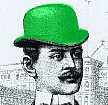 For
those of us who are modern but nostalgic, Issue
3 celebrates the development of "style freedom".
Cultural changes led the way to style freedom, which became evident during
the Elizabethan era when women gained
the right to appear on the theatrical stage, wearing their own clothes.
Unlike the days of La Belle Epoque,
it is now completely acceptable, even chic, for women to choose what styles
to wear by shopping for themselves in various places - from street markets
to traditional up-market boutiques. Some women even choose to search second-hand
shops to achieve a Vintage as New look.
With the liberation of women's hair, Hair Ornaments
have become less important as an essential and superficial part of one's
dress, and cherished more for their exquisite design and intrinsic value.
As more women were able to buy ready-made clothing and participate in
activities outside the home, the quiet art of sewing became appreciated
more for its decorative tools like elaborate Sewing
Kits and Thimbles. Perhaps
these freedoms inspired some to challenge Conventional
Dress for Men as well.
For
those of us who are modern but nostalgic, Issue
3 celebrates the development of "style freedom".
Cultural changes led the way to style freedom, which became evident during
the Elizabethan era when women gained
the right to appear on the theatrical stage, wearing their own clothes.
Unlike the days of La Belle Epoque,
it is now completely acceptable, even chic, for women to choose what styles
to wear by shopping for themselves in various places - from street markets
to traditional up-market boutiques. Some women even choose to search second-hand
shops to achieve a Vintage as New look.
With the liberation of women's hair, Hair Ornaments
have become less important as an essential and superficial part of one's
dress, and cherished more for their exquisite design and intrinsic value.
As more women were able to buy ready-made clothing and participate in
activities outside the home, the quiet art of sewing became appreciated
more for its decorative tools like elaborate Sewing
Kits and Thimbles. Perhaps
these freedoms inspired some to challenge Conventional
Dress for Men as well.| La Belle Epoque |
|
|
|
Hair
Ornaments
|
|
|
| Daring to Challenge |
 Until
recently, women were considered more fascinating for the personalities
they could assume through dress. Nancy Lyons discovered that
men, too, have not always suppressed their other - more charismatic
- personalities. Until
recently, women were considered more fascinating for the personalities
they could assume through dress. Nancy Lyons discovered that
men, too, have not always suppressed their other - more charismatic
- personalities. |
| Thimble Collecting |
| Bridget McConnel shares her passion for the imagination and delicate artistry found on antique thimbles and sewing tools. Thimble collecting is exciting, fun, and covers a wide price range. Each thimble is a perfect miniature display of art, invention and craftsmanship. |
| Vintage as the New Look |
 Those
of us who have always enjoyed vintage clothing are not surprised that
buying vintage is fashionable again. Itís hard to believe that not
long ago, only "eccentrics" shopped in vintage shops. Those
of us who have always enjoyed vintage clothing are not surprised that
buying vintage is fashionable again. Itís hard to believe that not
long ago, only "eccentrics" shopped in vintage shops.
|
| Elizabethan Clothing |
|
Jenny Tiramani, Associate Designer for Shakespeare's Globe in London, gave a fascinating introduction to the clothing worn by actors of the 16th and 17th centuries. Nancy Lyons reports that clothing worn on stage represented what was commonly worn by people of the Renaissance period. |
| Fashion History in the 20th Century |
|
|
No part of this website may be reproduced by any means without prior written permission from the producers.The producers of this website accept no responsibility for, nor necessarily agree with, views expressed, statements or claims made in any of the articles or events listings posted.
©www.aboutDecorativeStyle.com 2001
 Colin
Lawton Johnson
contributes his research on the fashion of the day. The
late Victorian era - the beginning of an era known as "la belle
époque" or "the beautiful period" (1890-1914)
- is a fascinating period for women's fashion.
Colin
Lawton Johnson
contributes his research on the fashion of the day. The
late Victorian era - the beginning of an era known as "la belle
époque" or "the beautiful period" (1890-1914)
- is a fascinating period for women's fashion.
 Sarah
Perkins detangles the topic of hair combs and ornaments. Popular
designs in jewellery often reflect the fashions of the day. Necklace
design is limited by the current trend in necklines, and bracelets
tend to be out of favour when cuffs are heavily frilled. The popularity
of hair ornaments was affected by two main factors: hairstyles &
hats.
Sarah
Perkins detangles the topic of hair combs and ornaments. Popular
designs in jewellery often reflect the fashions of the day. Necklace
design is limited by the current trend in necklines, and bracelets
tend to be out of favour when cuffs are heavily frilled. The popularity
of hair ornaments was affected by two main factors: hairstyles &
hats. Although
its scope is narrowed by a limited time frame, this rather slim
volume attempts to cover an undeniably huge subject. A History
of Fashion in the 20th Century manages this feat
in only 8 chapters which are concise but thought-provoking: "Beginnings
of Haute Couture," "The Roaring Twenties," "Fashion in Times of
Crisis," "The New Look in Full Swing," "Fashion Revolutions," "Flower
Power," "Dress for Success," and "Fin De Siecle".
Although
its scope is narrowed by a limited time frame, this rather slim
volume attempts to cover an undeniably huge subject. A History
of Fashion in the 20th Century manages this feat
in only 8 chapters which are concise but thought-provoking: "Beginnings
of Haute Couture," "The Roaring Twenties," "Fashion in Times of
Crisis," "The New Look in Full Swing," "Fashion Revolutions," "Flower
Power," "Dress for Success," and "Fin De Siecle".